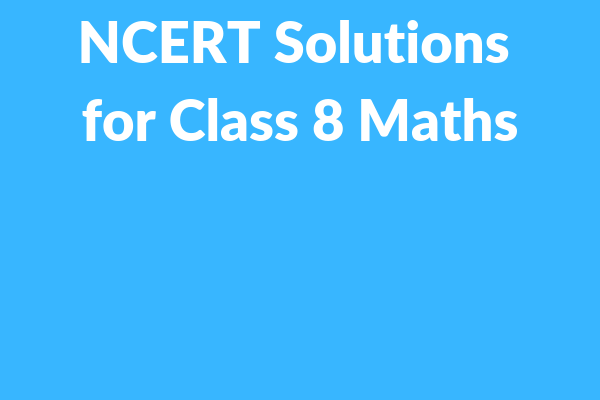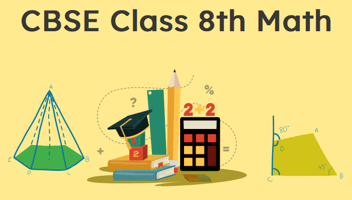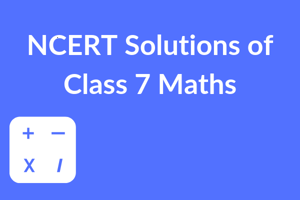Exams are the most stressful times in a student’s life, and students often tend to panic with...
8th Standard Maths CBSE Updated Chapters & Syllabus 2020-2021
Maths is not that “difficult” subject as it is often presumed to be. It is just based on logical, critical, and analytical thinking. Also, it doesn’t come all at once, learning maths is like stepping on small yet important stones, one at a time. class 8 maths consists of lessons that are major stepping stones for higher education in mathematics. 8th standard maths touches different topics in each chapter.
Some of the chapters are introduced to the students in the previous classes and hence, they have been continued further to understand more critical concepts. Class 8 maths plays a key role in building a strong foundation in maths in the CBSE system. Class 10 board exams, conducted by CBSE or the Central Board of Secondary Education is considered one of the most important examinations in the Indian education system. 8th standard maths deals with important lessons that are crucial for students to learn the class 10 maths board exam syllabus thoroughly.

When one is thorough with the primary, upper primary, and middle school mathematics, then maths is not quite a difficult subject to crack in the board exams. The ncert 8th class textbook is designed by the subject experts in a very interesting manner. It manages to stay consistent and informative while including many different topics in the syllabus. While some topics in the 8th class maths are easy, some may need more attention to be understood. Here we have a brief yet all-inclusive look at the class 8 math syllabus.
The ‘class 8 math question paper’ is designed based on 16 chapters included in the ncert 8th class textbooks. Below is a brief analysis of each of these 16 chapters.
Blog Contents
- 1 Chapter 1: Rational Numbers
- 2 Chapter 2: Linear Equations in One Variable
- 3 Chapter 3: Understanding Quadrilaterals
- 4 Chapter 4: Practical Geometry
- 5 Chapter 5: Data Handling
- 6 Chapter 6: Squares and Square Roots
- 7 Chapter 7: Cubes and Cube Roots
- 8 Chapter 8: Comparing Quantities
- 9 Chapter 9: Algebraic Expressions and Identities
- 10 Chapter 10: Visualizing Solid Shapes
- 11 Chapter 11: Mensuration
- 12 Chapter 12: Exponents and Powers
- 13 Chapter 13: Direct and Inverse Proportions
- 14 Chapter 14: Factorisation
- 15 Chapter 15: Introduction to Graphs
- 16 Chapter 16: Playing with Numbers
Chapter 1: Rational Numbers
The number system has been an important and integral part of the primary and upper primary maths syllabus. This lesson is elaborated in the class 8th math syllabus as well. However, it is more focussed here as it concentrates on the rational number alone at large. This chapter includes three important topics apart from the introduction and recalling the previous knowledge:
- Properties of Rational Numbers
- Representation of Rational Numbers on the Number Line
- Rational Number between Two Rational Numbers
Chapter 2: Linear Equations in One Variable
When we look at the maths syllabus in higher classes, it mainly consists of solving various equations in one variable, two variables, and so on. A very important foundation for solving these types of maths questions is laid in ‘8th grade maths’ with this chapter. Students here are introduced to various concepts for solving equations in one variable. The main topics covered are:
- Solving Equations which have Linear Expressions on one Side and Numbers on the Other Side
- Some Applications based on the concept
- Solving Equations having the Variable on both sides
- Some More Applications based on the variable on both sides
- Reducing Equations to Simpler Form
- Equations Reducible to the Linear Form
Chapter 3: Understanding Quadrilaterals
Solving shaped and geometry-based maths questions is often fun for many students as it involves some visualization. Quadrilaterals is quite an interesting chapter which deals with angles, the sum of angles, and different concepts. These include:
- Polygons
- Some of the Measures of the Exterior Angles of a Polygon
- Kinds of Quadrilaterals
- Some Special Parallelograms
Chapter 4: Practical Geometry
The 4th chapter in class 8 maths also deals with geometry. As the name suggests, Practical geometry requires students to use some geometrical instruments in order to solve some critical questions. This chapter has easy attention and interest of many students. The main concepts are:
- Introduction to the practical geometry
- Constructing a Quadrilateral
- Some Special Cases
Chapter 5: Data Handling
It is often noticed that students find data handling as fun and manageable lesson. While they find it interesting in solving questions based on data handling, this chapter also teaches them some important concepts useful in the real-world as well. When studied in detail, this forms an important base for higher-level professional education in the data handling and management sector. This chapter in the 8th standard maths syllabus includes the following main topics:
- Looking for Information
- Organizing Data
- Grouping Data
- Circle Graph or Pie Chart
- Chance and Probability
Chapter 6: Squares and Square Roots
Students have been introduced to the concepts of finding the Lowest Common Multiple and the Highest Common Factor in the maths syllabus till 7th class. The 6th chapter in the 8th grade maths takes this topic further and deeper and helps students in finding the squares and the square roots of numbers. This chapter introduces students to the following topics:
- Introduction to the squares and square roots
- Properties of Square Numbers
- Some More Interesting Patterns
- Finding the Square of a Number
- Square Roots
- Square Roots of Decimals
- Estimating Square Root
Chapter 7: Cubes and Cube Roots
This chapter is further elaborated to the 6th chapter. While in the last chapter, students were introduced to the concepts of squares and square roots, this chapter introduces them to cubes and cube roots. The main topics covered here in the 7th chapter of the ‘ncert 8th class’ syllabus are Introduction, Cubes, Cube Roots.
Chapter 8: Comparing Quantities
This is one of the crucial lessons that contribute to the class 8 math question paper. In this chapter, various important and critical points are covered. These are:
- Recalling Ratios and Percentages
- Finding the Increase and Decrease Percent
- Finding Discounts
- Prices Related to Buying and Selling (Profit and Loss)
- Sales Tax/Value Added Tax/Goods and Services Tax
- Compound Interest
- Deducing a Formula for Compound Interest
- Rate Compounded Annually or Half Yearly (Semi-Annually)
- Applications of Compound Interest Formula
Chapter 9: Algebraic Expressions and Identities
An important part of mathematics is algebra. We bet that many of us still remember those important algebraic formulas by heart. This is a very important chapter in 8th standard maths, helping students to understand the algebraic expressions and identities. The main topics covered here are:
- What are Expressions?
- Terms, Factors, and Coefficients
- Monomials, Binomials, and Polynomials
- Like and Unlike Terms
- Addition and Subtraction of Algebraic Expressions
- Multiplication of Algebraic Expressions: Introduction
- Multiplying a Monomial by a Monomial
- Multiplying a Monomial by a Polynomial
- Multiplying a Polynomial by a Polynomial
- What is Identity?
- Standard Identities
- Applying Identities
Chapter 10: Visualizing Solid Shapes
This chapter in the NCERT math book class 8 is one of the fun and activity-based lessons that students might find interesting. Some topics from this chapter might require a demonstration with 3D models for a better understanding. This chapter covers the following topics:
- Introduction
- View of 3D-Shapes
- Mapping Space Around Us
- Faces, Edges, and Vertices
Chapter 11: Mensuration
Just like algebra and number system, Mensuration is an important and key element of the class 8 maths syllabus and also, an important chapter that lays the foundation for higher class mathematics. This chapter in 8th grade maths includes the following topics:
- Introduction and recalling the previous knowledge
- Let us Recall
- Area of Trapezium
- Area of General Quadrilateral
- Area of Polygons
- Solid Shapes
- Surface Area of Cube, Cuboid, and Cylinder
- The volume of Cube, Cuboid, and Cylinder
- Volume and Capacity
Chapter 12: Exponents and Powers
This is one of the lessons in 8th standard maths that is extensively based on calculations and formulas. Exponents and powers are also an important concept in the higher classes maths especially when one studies mathematics as the main subject. This chapter includes:
- Introduction
- Powers with Negative Exponents
- Laws of Exponents
- Use of Exponents to Express Small Numbers in Standard Form
Chapter 13: Direct and Inverse Proportions
As the name suggests, this chapter is a brief introduction to the concepts of direct and inverse proportion. There are only two topics covered overall on this lesson: The Direct proportion and the Indirect proportion. This lesson in class 8 math syllabus can be treated as an introduction to an important concept that will be elaborated in the later classes.
Chapter 14: Factorisation
Remember all those factorization rules and methods that we had to remember and learn in class 8th? They formed a strong foundation for some important topics in class 10th maths board exams. The Factorization lesson in “class 8 maths” deals with the following important topics:
- Introduction
- What is Factorisation?
- Division of Algebraic Expressions
- Division of Algebraic Expressions Continued (Polynomial / Polynomial)
- Can you Find the Error?
Chapter 15: Introduction to Graphs
This chapter is perhaps one of the most interesting, practical, and activity-based. Remember pasting those graph papers in your maths notebook and solving questions out of them? We’re sure you would have found it interesting in many ways! This chapter in “8th standard maths” though only gives students a brief introduction to the graphs. This lesson includes the following topics:
- Introduction
- Linear Graphs
- Some Applications
Chapter 16: Playing with Numbers
This is the last chapter in the NCERT math book class 8. Touching some of the important topics in the number system, it includes the following concepts:
- Introduction to the important concepts
- Numbers in General Form
- Game with Numbers
- Letters for Digits
- Test of Divisibility
.png?width=100&height=100&name=Kapdec%20Logo%20(400px).png)


